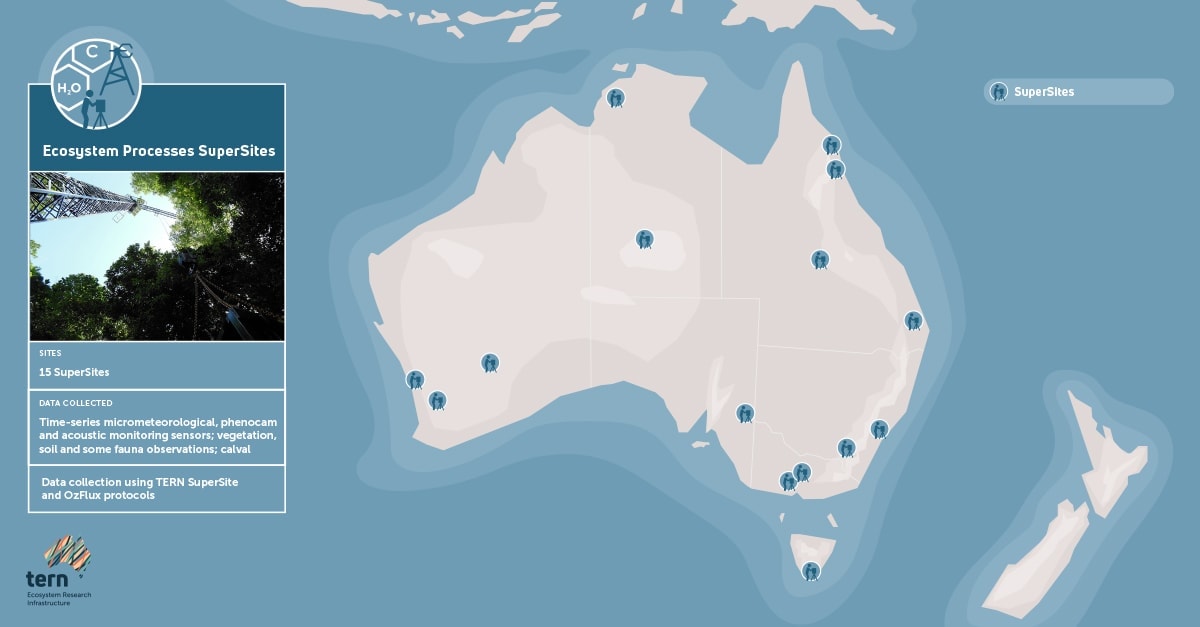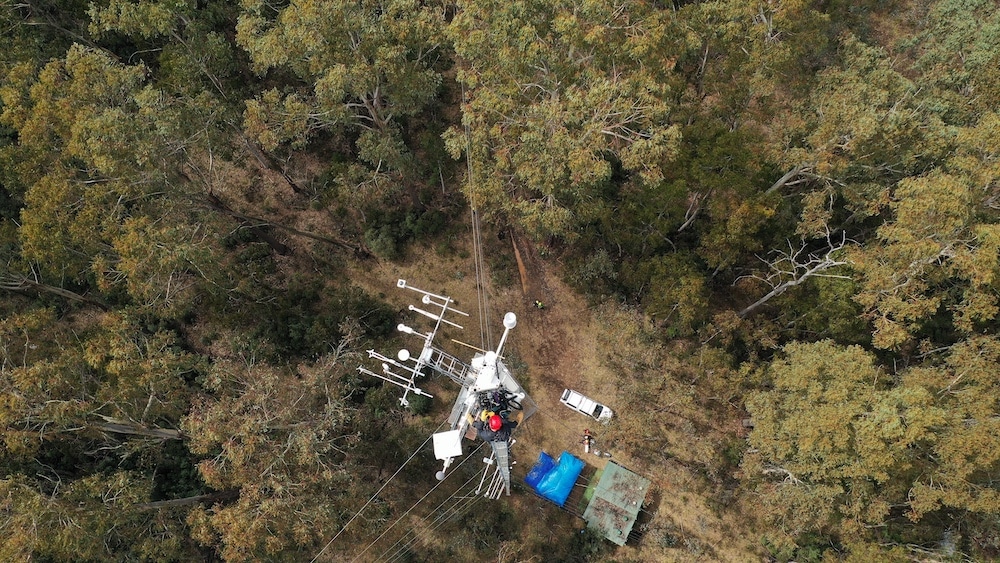Earth’s terrestrial biosphere currently absorbs nearly one-third of anthropogenic CO2 pollution. However, new research using TERN data suggests that rapid warming and increased emissions under business-as-usual climate scenarios might halve that absorption rate within decades.
Researchers from Northern Arizona University and the University of Waikato teamed up to determine whether any temperature limits would regulate the carbon uptake of Earth’s terrestrial biosphere.
Using TERN’s open-access data through FLUXNET, the world’s largest continuous carbon monitoring network, researchers determined photosynthesis and respiration changes attributed solely to changes in temperature. Measurements were analysed from every major biome across the globe, over more than two decades.
Long-term micrometeorological time-series data from 22 TERN-supported environmental monitoring sites were used in the global study.
While the researchers didn’t go into this analysis looking for a temperature tipping point, they certainly found one.

Alice Mulga SuperSite
Located on Pine Hill Cattle Station 200km north of Alice Springs, NT.
In arid and semi-arid country receiving less than 500mm of annual rainfall.
Litchfield Savanna SuperSite
Located in Litchfield National Park, 80km south of Darwin, NT.
High rainfall, frequently burnt, tropical savanna.
Great Western Woodlands SuperSite
Located at Credo Station, a former pastoral property in Western Australia’s Goldfields region, near Kalgoorlie, WA.
The largest remaining intact temperate or ‘Mediterranean’ woodland in the world.
Samford Peri-Urban SuperSite
Located in the peri-urban area 20kms north west of metropolitan Brisbane in the Samford Valley, QLD.
Supporting urban, agricultural and recreational land uses.
Boyagin Wandoo Woodland SuperSite
Located in the Boyagin Nature Reserve, approximately 12 km west of Pingelly, WA.
It is located in the Avon Wheatbelt and has semi-arid warm mediterranean climate.
Calperum Mallee SuperSite
Mallee semi-arid ecosystem, fringing the River Murray floodplains on Calperum Station, near Renmark, SA.
Undulating mallee woodlands and riverine vegetation fringing the river, recovering from extensive grazing.
Cumberland Plain Woodland SuperSite
Located in remnant Eucalyptus species woodland in the Cumberland Plain, at the University of Western Sydney’s Hawkesbury campus in Richmond, NSW.
Associated research infrastructure extends into the Blue Mountains ecoregion.
Daintree Rainforest SuperSite
TERN’s affiliate Daintree Rainforest SuperSite is comprised of two field sites, Daintree Rainforest Observatory (DRO) at Cape Tribulation. 120 km north of Cairns, QLD.
A long-term monitoring site, canopy crane and extensive researcher and teaching infrastructure. Nearby is the Daintree Discovery Centre site, an ecotourism interpretive centre with canopy tower, flux tower, aerial walkway and scientific monitoring.
Robson Creek Rainforest SuperSite
Located on the Atherton Tablelands in Danbulla National Park within the Wet Tropics World Heritage area.
The site’s climate is seasonal with approximately 60% of annual rainfall falling between January and March. The landform is moderately inclined although rises to 1276m to the north.
Gingin Banksia Woodland SuperSite
Located on the Swan Coastal Plain, 10km southwest of Gingin, near Perth, WA, land traditionally owned by the Yued group of the Noongar people.
A natural woodland of high species diversity dominated by Banksia spp, that overlays the Gnangara groundwater mound.
Mitchell Grass Rangeland SuperSite
Located near Longreach in western Queensland in the Mitchell Grass Downs IBRA bioregion, that covers approximately 47 million hectares (14% of Queensland and 6% of Australia).
Tumbarumba Wet Eucalypt SuperSite
Located in the Bago State Forest, near Batlow, NSW.
Managed, open wet sclerophyll Eucalypt forest, roviding records over a decade on the weather, climate, net uptake of CO2 and loss of water via evapotranspiration.
Warra Tall Eucalypt SuperSite
60km west south-west of Hobart, TAS. It lies partly within the Tasmanian Wilderness World Heritage Area and within State forest.
Tall, wet Eucalyptus obliqua forests predominate and are part of the cool, temperate wet forest biome.
Whroo Dry Eucalypt SuperSite
4 km south-west of Shepparton, VIC on the lands of the Ngurai-illam-wurrung Aboriginal people.
Classified as box woodland, dominated by two main Eucalypt species (Eucalyptus microcarpa (Grey Box) and Eucalyptus leucoxylon (Yellow Gum)).
14 of 16Wombat Stringybark Eucalypt SuperSite
Located in the Wombat State Forest, near Ballarat, VIC.
Investigating the impacts of climate change and disturbances, such as fire and drought, on the dry sclerophyll eucalypt forests in southeast Australia.
NEW! Fletcherview Tropical Rangeland SuperSite
Located at James Cook University’s Fletcherview Research Station, two hours west of Townsville, Qld.
Open savanna woodland, dry rainforest, lava flows, three creek systems and the Burdekin River.
Long-term micrometeorological time-series data from 22 TERN sites, including 15 SuperSites (above), were used in the global study
Tipping point shifts Earth from carbon ‘sink’ to carbon ‘source’
“We originally aimed to simply derive a temperature dependence curve for global photosynthesis and respiration,” said lead researcher Dr Katharyn Duffy from Northern Arizona University.
“The temperature tipping point emerged from the data once we had a temperature dependence curve, and compared it to current and future climate,” she said.
This tipping point describes a critical temperature threshold at which plants begin to release carbon into the atmosphere faster than they can sequester it, contributing to atmospheric carbon levels rather than mitigating them.
The data revealed that global photosynthesis rates reach a peak at around 18°C for C3 plants, and 28°C for C4 plants, and declines at higher temperatures, while respiration rates continue to increase without appearing to reach a maximum temperature threshold.
This means that with continued warming, photosynthesis rates will more than likely decline while respiration rates will rise exponentially, tipping the terrestrial biosphere from a carbon sink to a carbon source.
Co-author Professor Vickery Arcus said that the most striking result from this research was “how close in time we are to the [tipping] point”.
Lead author Dr Katharyn Duffy agreed by saying “when we realised that we were beginning to cross the temperature tipping point now, we collectively had an ‘oh no, we must be wrong’ moment”.
“The temperature tipping point of the terrestrial biosphere lies not at the end of the century or beyond, but within the next 20 to 30 years” the study warns.
Carbon-rich biomes could suffer biggest losses
Biomes that are currently cycling 40 to 70 percent of all terrestrial carbon, including the rainforests of the Amazon and Southeast Asia, and the Taiga forests of Russia and Canada, may be among the first to reach the tipping point and could lose nearly half their carbon sink capacity by mid-century.
According to the study, “while biomes will eventually shift spatially in response to warming, this process is unlikely to be a smooth migration, but rather a rapid disturbance-driven loss of present biomes (with additional emissions of carbon to the atmosphere), followed by a slower establishment of biomes more suited to the emerging climate”.
Preserving fragile ecosystem services
Lead author Dr Katharyn Duffy said that this study points out that “the ecosystem services that the biosphere currently provides us (climate and otherwise) are far more fragile than we previously realised”.
“We need to account for this fragility when considering climate negotiations,” she said.
The study notes that capping global warming under 2°C above pre-industrial levels (RCP2.6) “allows for near-current levels of biosphere productivity, preserving the majority of land carbon uptakes.”
Long-term monitoring paramount to tracking and forecasting environmental change
The findings of this research were made possible thanks to open-access to more than two decades of ecosystem observation via NCRIS-enabled TERN and similar research infrastructure groups around the globe.
The next step for this research is to better understand how resilient ecosystems will be to temperature changes in the future, says lead author Dr Katharyn Duffy.
“So far, plants don’t appear to be acclimatising to the change, and we think that they’re unlikely to do so to a significant extent in the immediate future”.
However, to track these trends and forecast when we expect ecosystems to experience mortality, we need consistent long-term and spatially diverse monitoring data.
“As we spend more and more time past the maximum for photosynthesis we need to continue to ask these data about temperature effects, keep looking for temperature acclimation, and track lethal temperatures” said Dr Duffy.
The continued provision of the global FLUXNET dataset via its national research infrastructures, like TERN in Australia, is of supreme importance to these research endeavours.

Long-term data collected at TERN’s Litchfield Savanna SuperSite were used in the study







